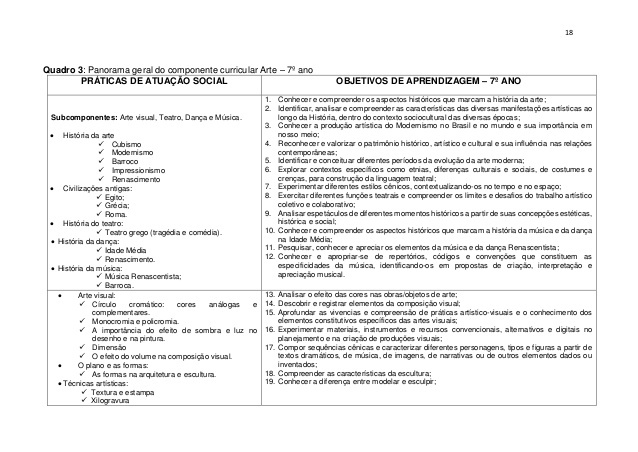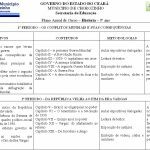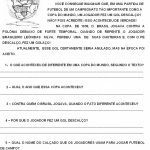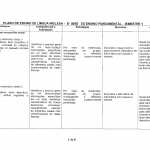Congratulations on your initiative and collaboration with the teaching of the arts!
This material is of paramount importance to provide support and guidance to start a good job in schools!
Planning is essential in any professional environment, including for the teacher. With the lesson plan, the teacher is more likely to succeed in the learning process, so that uninteresting, monotonous and disorganized lessons are avoided. Teachers can create an annual, semiannual or bimonthly lesson plan, the interesting thing about the annual lesson plan is that the professionals are able to follow the development and if they need to update the plan, an important point is to save time during the school year.
It can work for any discipline, in fact it is essential for any discipline, but one of them is not very well explored, art. Many people believe that art is not a discipline, but those who think that way are wrong. Therefore, we selected some example of an art-oriented lesson plan.
The lesson plan must be effective, objective, with clear language and prepared in an organized way, must contain - necessarily - some topics, such as:
– Header (where the data of the educational institution, the class, teacher's name, subjects to be covered, etc.) will be
– Theme of the class (subject covered),
– General and specific objectives (which skills and abilities the teacher expects students to develop, based on the proposed activities),
– Teaching resources (materials to be used),
– Methodology (how the class will be developed),
– Assessment (how they will be assessed if objectives have been achieved).
fundamental-class-plan modelEach subject can be worked in an isolated or interdisciplinary way, it depends on the pedagogical tendency and philosophy adopted by the educational institution.
Lesson Plan Templates
The lesson plan allows the teacher, as far as possible and desirable, to maintain the articulation of the discipline, as a whole, in relationship with the teaching plan and also carry out a self-assessment of the class or a cooperative assessment to guide decisions future.
So, we've put together some model lesson plans for the 6th, 7th, 8th and 9th grades, this should help you prepare your plan:
CLICK ON THE IMAGE TO ENLARGE!





ANNUAL PLANNING
(6th and 7th year of Elementary School)
General Objectives of the area:
• Know, reflect and analyze each artistic language in its historical and socio-cultural context.
• Express knowing how to communicate in art, maintaining an attitude of personal or collective search, articulating the perception, imagination, emotion, investigation, sensitivity and reflection when making and enjoying productions artistic.
• Know materials, instruments and procedures varied in the arts (Visual Arts, Dance, Music, Theatre), to use them in personal work and identify them culturally.
• Build a relationship of self-confidence with personal artistic production and aesthetic knowledge, respecting one's own production and that of colleagues in the course of creation.
• Identify, relating the different functions of art, work and production of artists throughout human history.
• Understand the relationships between art and reality, reflecting, investigating, inquiring, with interest and curiosity, exercising discussion, sensitivity, arguing and appreciating art in a sensitive way.
• Recognize indigenous and African cultures as some of the legitimate matrices of Brazilian culture.
• Valuing one's ethnic identity, strengthening self-esteem.
Skills to be developed
• Create, articulating perception, imagination, sensitivity, knowledge and personal and group artistic production.
• Identify visual forms, in the frequent work of relationships between elements that compose them, such as point, line, plane, color, texture, movement and rhythm.
• Represent ideas, emotions, sensations through visual arts, theater, dance and music.
• Identify the relationships between Art and other areas of human knowledge (Physical Education, in the Dance and Rhythm Project and Portuguese language in the adapted script), establishing the connections between them, knowing how to use such areas in personal work and collectives.
• Build a relationship of cooperation, respect, dialogue and appreciation of the various choices and possibilities for interpretation and creation, in relation to colleagues.
• Appreciate the Northeastern Culture, establishing its relationship with other artistic modalities and other areas of knowledge.
• Define the concept of Art and beautiful.
• Identify warm, cold, primary and secondary colors.
• Use painting techniques in your personal production.
• Appreciate music and its historical context.
Enjoy the festivals of northeastern culture.
ART CONTENT
6th and 7th Year of Elementary School
1st semester content
1st semester
Introduction to the analysis of artistic images
• Concept of Art (figurative art and abstract art).
• Concept of the Beautiful (observing works of art and making reinterpretations).
• Function of Art.
art history
• Prehistory
• Indigenous art
• Ritual dances, ceremonial artifacts, body painting, basketwork, music, ceramics and everyday objects.
• African art.
• Utensils, furniture, sculpture, paintings, tattoos, drawings, masks, handicrafts, etc.
• The beautiful in the African conception.
Morphology (study of geometric shapes)
• Point, line, plane and angles.
• The square, circle, triangle and rectangle.
Creative Geometry
• Lines, letters and numbers.
• Tangram
• Lines and shapes
• Creating shapes.
• Artistic expressiveness of lines.
• The square, circle, triangle and rectangle.
color study
• Origin and evolution
• Primary and secondary colors.
• Warm and cool colors.
• Psychological aspects of colors.
Northeastern Culture
• Regional festivals
• Folklore
• Historical monuments.
MACRO ACTIVITY:
Folk dances from our region
2nd Semester
Plastic expression
• Painting techniques (with crayons, felting pen, colored chalk, colored pencils, gouache, among others)
• Art collage and mosaic (techniques, materials, research and creativity).
• Mixed painting technique (mixture of materials and/or techniques).
• Texture
Song
• Music history.
• Musical language / music genres.
theater
• Origin of Greek Theater
• Masks and puppets.
• Scenic language.
MACRO ACTIVITY:
Project: Interdisciplinary Cultural Fair (All 6th and 7th year subjects)
Project: DANCE – Art and Physical Education
ART CONTENT
Teacher: FABIANA DALIARK DA SILVA CASADO
8th and 9th Year of Elementary School
General Objectives of the area:
• Know, reflect and analyze each artistic language in its historical and socio-cultural context.
• Express knowing how to communicate in art, maintaining an attitude of personal or collective search, articulating the perception, imagination, emotion, investigation, sensitivity and reflection when making and enjoying productions artistic.
• Know materials, instruments and procedures varied in the arts (Visual Arts, Dance, Music, Theatre), to use them in personal work, identify them culturally.
• Build a relationship of self-confidence with personal artistic production and aesthetic knowledge, respecting one's own production and that of colleagues in the course of creation.
• Identify, relating the different functions of art, work and production of artists throughout human history.
• Understand art as a historical fact contextualized in different cultures, knowing, respecting and being able to observe the productions present in the surroundings, as well as cultural heritage and the natural universe, identifying the existence of differences in the artistic and aesthetic standards of different groups cultural.
• Understand the relationships between art and reality, reflecting, investigating, inquiring, with interest and curiosity, exercising discussion, sensitivity, arguing and appreciating art in a sensitive way.
• Promote, through art, the development of skills, abilities and knowledge necessary for the systematic formation of the student.
• Recognize indigenous and African cultures as some of the legitimate matrices of Brazilian culture.
• Valuing one's ethnic identity, strengthening self-esteem.
Skills to be developed in Grade 8 and 9
• Properly use various art techniques with research, experimentation and communication procedures.
• Develop a relationship of self-confidence with personal artistic production, linking their own production with that of others, valuing and respecting aesthetic, artistic and gender diversity.
• Register and document information obtained from artists, documents, books, etc., relating them to their own personal experiences, as creators, interpreters and art lovers (dance, visual arts, music and theater).
• Appreciate, discuss, reflect and adopt respectful attitudes towards the variety of musical manifestations.
• Analyze the musical interpretations that take place contemporaneously between them, reflecting on their respective aesthetics.
• Know the history of Brazilian theater during the 18th and 19th centuries.
• Conceptualize Brazilian popular music.
• List the top museums in the world.
• Define Impressionism, Expressionism, Cubism, Surrealism and Dadaism.
ART CONTENT
8th and 9th Year of Elementary School
1st semester content
1st semester
• Post-impressionism
• Neo-impressionism
• Expressionism
2. Colors
• Psychological aspects of colors
• Working with scraps
2. Craftsmanship
• Brazilian
• Indigenous
• Afro-Brazilian
• African
MACRO ACTIVITY: Folk music from our region
2nd Semester
• Theatrical language
2. Song
• Musical language
• Popular Brazilian Music
• Northeastern Popular Music
3. museums
• Top museums in the world
MACRO ACTIVITY:
Project: Interdisciplinary Cultural Fair (All 8th and 9th Grade subjects)
Project: DANCE – Art and Physical Education
Did you like it? Share this post on your social network
 6th to 9th Year Annual History Plan
6th to 9th Year Annual History Plan
 ACTIVITY IDEAS WITH PARENTHESES
ACTIVITY IDEAS WITH PARENTHESES
 Text Interpretation Activities to Print
Text Interpretation Activities to Print
![Science descriptors Elementary School [COMPLETE]](/f/49b52b38501cfe470e8f5201ad1eceb3.jpg) Science descriptors Elementary School [COMPLETE]
Science descriptors Elementary School [COMPLETE]
 Percentage Exercises for Elementary School
Percentage Exercises for Elementary School
 ANNUAL PLAN ENGLISH 6TH TO 9TH YEAR
ANNUAL PLAN ENGLISH 6TH TO 9TH YEAR
Congratulations on your initiative and collaboration with the teaching of the arts!
This material is of paramount importance to provide support and guidance to start a good job in schools!
Thanks for sharing, don't know how it helps!
God blesses!
Very nice comments and observations if possible send them to the email below
thanks! helped me a lot
This site uses Akismet to reduce spam. Learn how your comment data is processed.
